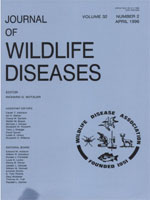Eighteen free-ranging white-tailed deer (Odocoileus virginianus) were captured near Chestertown, Maryland (USA) from 15 February to 21 March, and 7 October to 13 November 1986. Deer were immobilized by intramuscular injection of 1.1 to 2.2 mg/kg xylazine hydrochloride and 1.8 to 4.4 mg/kg ketamine hydrochloride. Four captive deer from The Pennsylvania State University, Pennsylvania (USA), were immobilized on 16 September 1986 with 1.5 to 2.0 mg/kg xylazine hydrochloride. Intramuscular injection of yohimbine hydrochloride (0.4 mg/kg) was used to antagonize the immobilizations. Free-ranging adult (≥17 months) males could stand after a mean (±SE) time of 7.3 ± 2.4 min, adult females after 8.6 ±1.7 min, male fawns after 5.7 ± 3.3 min, and female fawns after 8.9 ±1.9 min. Captive adult males could stand after 20.2 ± 3.4 min. Intramuscular injections of yohimbine hydrochloride effectively and safely antagonized the xylazine hydrochloride in immobilized deer and were easier to administer than intravenous injections.
How to translate text using browser tools
1 April 1996
Antagonism of Xylazine in White-Tailed Deer with Intramuscular Injection of Yohimbine
Bret D. Wallingford,
Richard A. Lancia,
Edward C. Soutiere

Journal of Wildlife Diseases
Vol. 32 • No. 2
April 1996
Vol. 32 • No. 2
April 1996
antagonist
immobilization
intramuscular injection
Odocoileus virginianus
white-tailed deer
xylazine hydrochloride
yohimbine hydrochloride




